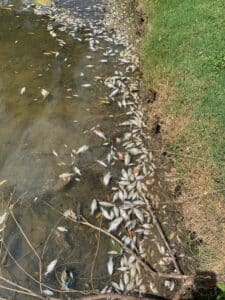Weather conditions dictate “what, when, and how” algaecide or herbicides should be applied to a pond. To ensure proper efficacy, pond products shouldn’t be applied during rain or immediately after rain events. Most algaecides/herbicides have minimal “contact” times that must be met in order to be effective. Even a light rain shower can wash the product off of its intended target. You not only want to keep the product on the pest, but you also do not want the product to move off target onto desirable species, landscaped areas, or into groundwater.
High winds prevent proper application of pond products. In fact, the labels of most products makes them illegal to use in winds greater than 10 mph. Some aquatic herbicides can damage desirable landscaping such as grass, trees, shrubs, etc. As a result, it is important to read the product labels before use. In order to prevent product drift, you should never apply non-selective herbicides in high winds. Even under light wind conditions it is important to treat only from the upwind side of the pond.

Fish Kill Due to Over Treatment
Extremely hot weather increases the risk of fish suffocation due to low dissolved oxygen. Decomposing algae/submersed weeds lower the oxygen levels in ponds. When treating expansive areas of algae or weeds with contact products, it is important to treat the pond in sections. For example, treat only 1/3rd of the pond at a time and maintain a 14 day interval between subsequent treatments. This will prevent rapid oxygen depletions due to decomposition. That being said, there are certain times of the year when all algaecide/herbicide applications should be put on hold. These are the dog days of summer when we have extended streaks of 100+ degree days with little or no wind.
Cold weather can have negative impacts on the efficacy of aquatic products. Some products have a minimum water temperature at which the product becomes ineffective. Many product labels specify that the pest must be actively growing at the time of treatment. If the pest is dormant, then it will not uptake the product. This results in wasted product and wasted funds.
And finally, algaecides/herbicides are most effective when applied on sunny days. Since algae and aquatic weeds make their own food through photosynthesis, they require sunlight for their normal biological processes. The active ingredients in aquatic products disrupt these biological processes and ultimately kill the pest. Therefore, a pest growing under normal conditions (direct sunlight) will most efficiently uptake the product.
If you are unsure of “what, when, and how”, we recommend that you contact a qualified lake management professional.
